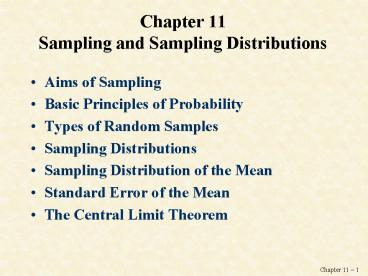Chapter 11 Sampling and Sampling Distributions PowerPoint PPT Presentation
1 / 20
Title: Chapter 11 Sampling and Sampling Distributions
1
Chapter 11Sampling and Sampling Distributions
- Aims of Sampling
- Basic Principles of Probability
- Types of Random Samples
- Sampling Distributions
- Sampling Distribution of the Mean
- Standard Error of the Mean
- The Central Limit Theorem
2
Sampling
- Population A group that includes all the cases
(individuals, objects, or groups) in which the
researcher is interested. - Sample A relatively small subset from a
population.
3
Notation
4
Sampling
- Parameter A measure (for example, mean or
standard deviation) used to describe a population
distribution. - Statistic A measure (for example, mean or
standard deviation) used to describe a sample
distribution.
5
Sampling Parameter Statistic
6
Probability Sampling
- Probability sampling A method of sampling that
enables the researcher to specify for each case
in the population the probability of its
inclusion in the sample.
7
Random Sampling
- Simple Random Sample A sample designed in such
a way as to ensure that (1) every member of the
population has an equal chance of being chosen
and (2) every combination of N members has an
equal chance of being chosen. - This can be done using a computer, calculator, or
a table of random numbers
8
Population inferences can be made...
9
...by selecting a representative sample from the
population
10
Random Sampling
- Systematic random sampling A method of sampling
in which every Kth member (K is a ration obtained
by dividing the population size by the desired
sample size) in the total population is chosen
for inclusion in the sample after the first
member of the sample is selected at random from
among the first K members of the population.
11
Systematic Random Sampling
12
Stratified Random Sampling
- Stratified random sample A method of sampling
obtained by (1) dividing the population into
subgroups based on one or more variables central
to our analysis and (2) then drawing a simple
random sample from each of the subgroups
13
Stratified Random Sampling
- Proportionate stratified sample The size of the
sample selected from each subgroup is
proportional to the size of that subgroup in the
entire population. - Disproportionate stratified sample The size of
the sample selected from each subgroup is
disproportional to the size of that subgroup in
the population.
14
Disproportionate Stratified Sample
15
Sampling Distributions
- Sampling error The discrepancy between a sample
estimate of a population parameter and the real
population parameter. - Sampling distribution A theoretical
distribution of all possible sample values for
the statistic in which we are interested.
16
Sampling Distributions
- Sampling distribution of the mean A theoretical
probability distribution of sample means that
would be obtained by drawing from the population
all possible samples of the same size. - If we repeatedly drew samples from a population
and calculated the sample means, those sample
means would be normally distributed (as the
number of samples drawn increases.) The next
several slides demonstrate this. - Standard error of the mean The standard
deviation of the sampling distribution of the
mean. It describes how much dispersion there is
in the sampling distribution of the mean.
17
Distribution of Sample Means with 21 Samples
10 8 6 4 2 0
S.D. 2.02 Mean of means 41.0 Number of Means
21
Frequency
37 38 39 40 41 42 43 44 45 46
Sample Means
18
Distribution of Sample Means with 96 Samples
14 12 10 8 6 4 2 0
S.D. 1.80 Mean of Means 41.12 Number of Means
96
Frequency
37 38 39 40 41 42 43 44 45 46
Sample Means
19
Distribution of Sample Means with 170 Samples
30 20 10 0
S.D. 1.71 Mean of Means 41.12 Number of Means
170
Frequency
37 38 39 40 41 42 43 44 45 46
Sample Means
20
The Central Limit Theorem
- If all possible random samples of size N are
drawn from a population with mean ?y and a
standard deviation , then as N becomes
larger, the sampling distribution of sample means
becomes approximately normal, with mean ?y and
standard deviation .

